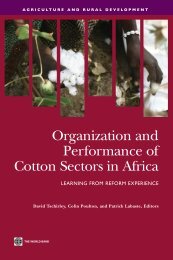Constraints to smallholders participation in Cassava value ... - aaacp
Constraints to smallholders participation in Cassava value ... - aaacp
Constraints to smallholders participation in Cassava value ... - aaacp
Create successful ePaper yourself
Turn your PDF publications into a flip-book with our unique Google optimized e-Paper software.
especially the M<strong>in</strong>istry of Agriculture and Cooperatives (MACO), have demonstrated significantpolitical commitment, and realisation of the objectives will be enhanced by private sec<strong>to</strong>r leadership.Mov<strong>in</strong>g <strong>to</strong>wards implementation of the strategy, there are challenges for both cont<strong>in</strong>uity andadequate <strong>participation</strong> and subsec<strong>to</strong>r representation: grassroots <strong>in</strong>volvement from producers andsmall-scale traders is critical <strong>to</strong> enhance knowledge of and communication with<strong>in</strong> supply systems;and the creation of awareness of bus<strong>in</strong>ess opportunities with<strong>in</strong> the bank<strong>in</strong>g and legal sec<strong>to</strong>rs, withthe formulation of <strong>in</strong>novative f<strong>in</strong>ancial and organisational arrangements will <strong>in</strong>crease the rate andscale of sec<strong>to</strong>r growth.As the process of strategy formulation cont<strong>in</strong>ues, stakeholders need <strong>to</strong> <strong>in</strong>corporate <strong>in</strong><strong>to</strong> theirth<strong>in</strong>k<strong>in</strong>g the diverse challenges and uncerta<strong>in</strong>ties concern<strong>in</strong>g the realisation of the potential of thesec<strong>to</strong>r, among which are the follow<strong>in</strong>g questions:• What is the smallholder farmers’ propensity <strong>to</strong> grow cassava <strong>to</strong> enhance food security and<strong>to</strong> supply agro<strong>in</strong>dustrial demand?• What are the mechanisms for articulat<strong>in</strong>g effective demand from consumers and <strong>in</strong>dustrialusers through the supply cha<strong>in</strong> <strong>to</strong> producers?• How can enhanced supply cha<strong>in</strong> l<strong>in</strong>kages be f<strong>in</strong>anced and leveraged by policy makers?• What <strong>in</strong>centive and governance structures can be put <strong>in</strong> place <strong>to</strong> facilitate new commercial<strong>in</strong>itiatives and public <strong>in</strong>terventions?• What are the additional data requirements for accurate policy formulation <strong>to</strong> boost thesec<strong>to</strong>r?1.3 Smallholder capacity and <strong>participation</strong>In general, it can be asserted that, ceteris paribus, farmers are likely <strong>to</strong> adapt patterns of production<strong>in</strong> accordance with new opportunities. Govereh et al. (2010) have argued that the adoption ofcassava as a food crop by <strong>smallholders</strong> outside the traditional areas was favoured or promoted bypolicy changes affect<strong>in</strong>g the maize market: a reduction <strong>in</strong> support reduced the attractiveness ofmaize vis-à-vis alternative production systems, result<strong>in</strong>g <strong>in</strong> a process of agricultural diversificationthat <strong>in</strong>cluded <strong>in</strong>creased cassava production. The concurrent promotion of the sec<strong>to</strong>r throughresearch, development and dissem<strong>in</strong>ation of IVs was timely and the effects of these sec<strong>to</strong>rprogrammes are be<strong>in</strong>g felt <strong>in</strong> regions beyond the cassava belt. Further growth <strong>in</strong> cassava productioncan be expected. The strategy envisages a massive supply response from a host of small scaleproducers who grow small quantities primarily for on-farm consumption, with demand signals andproduct market<strong>in</strong>g transmitted through a traditional market system which manifests almost nocharacteristics of modern supply cha<strong>in</strong> management.Nevertheless, smallholder <strong>participation</strong> <strong>in</strong> the cassava <strong>value</strong> cha<strong>in</strong> will depend not only on themarket and policy <strong>in</strong>centives which they face but also the specific constra<strong>in</strong>ts <strong>in</strong>ternal and external<strong>to</strong> the <strong>in</strong>dividual household or productive unit. The attractiveness of the <strong>in</strong>centives is a function bothof policy and organisations, and of the <strong>in</strong>stitutional and donor environments. The entrepreneurialpredisposition of Zambian <strong>smallholders</strong> is not <strong>in</strong> question, but the effective capacity <strong>to</strong> respond <strong>to</strong>opportunities and <strong>in</strong>itiatives depends, <strong>in</strong>ter alia, on human assets and attitudes.While grow<strong>in</strong>g conditions for expand<strong>in</strong>g cassava output <strong>in</strong> the northern and western regions <strong>to</strong> meet<strong>in</strong>dustrial demand are satisfied, high transport costs <strong>to</strong> sites of <strong>in</strong>dustrial transformation must beaddressed. This requires upgrad<strong>in</strong>g of roads and competitive transport systems. Moreover, <strong>in</strong>production areas, concentration of supplies, efficient contract<strong>in</strong>g and quality control through group7
















